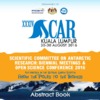Chwedorzewska K. J., H. Galera, S. Łapiński, M. E. Kowalska, M. Pasik, M. Rajner, E. Czyż, P. Bylina, A. Znój i M. Wódkiewicz. „First step to eradication of Poa annua L. from Arctowski Oasis (King George Island, South Shetlands, Antarctica)”. scar 2016 Open Science Conference. Kuala Lumpur, Malezja, isbn 978-0-948277-32-0.
- [bib]
@conference{Chwedorzewska16,
}eventtitle = {scar 2016 Open Science Conference}, eventdate = {2016-08-20/2016-08-30}, year = {2016}, address = {Kuala Lumpur, Malezja}, author = {Chwedorzewska, Katarzyna J. and Galera, Halina and Łapiński, Sławomir and Kowalska, Maria Elżbieta and Pasik, Mariusz and Rajner, Marcin and Czyż, Ewa and Bylina, Paweł and Znój, Anna and Wódkiewicz, Maciej}, title = {First step to eradication of Poa annua L. from Arctowski Oasis (King George Island, South Shetlands, Antarctica)}, isbn = {978-0-948277-32-0}, month = {aug}, presenter = {Katarzyna Chwedorzewska}, - [streszczenie]
Poa annua is the only flowering plant species that has established a breeding population in the maritime Antarctic, through repeated anthropogenic introduction. Annual bluegrass inhabits mainly anthropogenic sites, but recently has entered tundra communities. The functioning of P. annua in the Antarctic could not have been possible without adaptations that enable the plants to persist in the specific climatic conditions typical for this zone. Poa annua is highly adaptable to environmental stress and unstable habitats: huge phenotypic and genotypic variability, small size, plastic life cycle (life-history types ranging from annual to perennial forms). The spreading of P. annua in the Antarctic Peninsula region is a classic example of the expansion process following anthropogenic introduction of an invasive species, and illustrates the dangers to Antarctic terrestrial ecosystems that are associated with increasing human traffic. We report the first steps to eradicate the species after all the necessary initial research has been conducted. After detailed mapping a part of the ―Arctowski‖ population closest to a valuable moss carpet formation has been removed. We removed altogether 314 out of 1439 tussocks growing in the vicinity of Station buildings and all of the 49 tussocks growing in the forefield of Ecology Glacier. In subsequent years we will continue the eradication process and monitor the eradicated sites. This will provide valuable information on procedures concerning removal of alien species in the maritime Antarctic and will help making future informed decisions for other invasions in the region.
- [.pdf]
